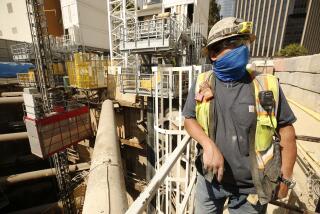What firms will stimulus help?
While politicians in Washington tinkered with the final compromise version of the $787-billion economic stimulus bill Thursday night, Alonso Arellano was working late in his office, putting the final touches on his own economic stimulus package.
His bid to boost consumer spending was to launch the next day, when lunch customers at his La Adelita restaurant in Sun Valley could pay just $4.99 for a scaled-down serving of chili rellenos, chicken mole, chili verde, beef stew or other popular dishes.
The first-ever lunch specials at the 11-year-old eatery, where regular entrees cost $9 to $17, are meant to capture consumers who are seeking lower prices, Arellano said.
Sales have plunged 50% compared with early 2008 at his businesses, which include a small tortilla-making operation and a retail bakery. As a result, he has laid off half his 16-person staff. Taking steps to restore consumer confidence is the best way out of the recession for small businesses such as his family firm, he said.
“If I had a magic wand, I would help the consumers around my community,” said Arellano, who also sits on the board of the Latin Business Assn., based in Los Angeles. “Then that will help me because they will come back and start eating out again.”
He’s hoping spending and tax-cut provisions in the stimulus bill and the $50-billion foreclosure prevention plan the Obama administration is working on will boost consumer spending by improving access to credit and creating jobs.
Arellano said he wouldn’t be helped by provisions to loosen lending backed by the Small Business Administration and to allow businesses with sales of $15 million or less to use current losses to get tax refunds for up to five previous years.
He didn’t need a loan to fund the $125,000 launch last year of a new version of the handmade corn tortillas his workers produce. The Nopaltilla, made with nopal cactus powder touted for its healthful properties, is flying off the shelves at one of four test markets, he said, but lingering in more traditional Latino areas.
For Arellano, who is a part owner in two other restaurants, and many other small-business operators, consumers are the bottom line. If customers have money and the confidence to spend it, small firms will survive the lengthy recession. If not, tough times will continue.
At G&C; Equipment Corp. in Gardena, owner Gene Hale also isn’t hanging his hopes on tax cuts or SBA lending provisions in the stimulus bill.
Sales are down just 10% from year-earlier levels at the contractor, which supplies construction materials and supplies to large-scale projects including L.A. Live, Staples Center and public schools.
But the firm’s backlog of work has shrunk to about four months from about eight months, said Hale, who is also chairman of the Greater Los Angeles African American Chamber of Commerce. He hasn’t had to lay off any of his 14 workers but has left a few positions unfilled.
Many small firms don’t make enough money to get a big shot of cash through the tax breaks in the stimulus bill, and SBA lending doesn’t touch most small companies, he said. He’s more concerned about where the billions of dollars in infrastructure spending will end up: in big-business pockets or at small firms.
Current law lets big companies play a “good-faith effort” game that lets them off the hook when it comes to actually hiring enough small subcontractors, Hale said.
If that happens with stimulus infrastructure spending, “the president and everybody is going to feel the wrath of the small-business community because they are going to say it’s business as usual,” said Hale, who started his firm in 1981.
Hale was in Washington last week on business but also to pitch his ideas to politicians. He wants incentives and monitoring put in place to ensure that large contractors who land new work through the stimulus bill’s infrastructure spending actually share the work with small firms.
He’d also like to see a presidential advisory board on small business set up to advise the administration and work with federal agencies.
Most businesses never take out SBA-backed loans, which are meant for those that can’t quality for a conventional small-business bank loan. But the main loan programs -- the 7(a) for start-up and working capital, and the 504 for real estate and asset-backed loans -- are often watched to judge credit access for small firms.
Both the number of loans and the dollar volume are down by roughly half in the three months ended Dec. 31 -- the first quarter of the federal fiscal year -- compared with a year earlier. The 7(a) loan program saw a 57% decline to 8,996 loans in the period compared with 20,859 a year earlier, while dollars lent dropped 40% to $1.9 billion.
The 504 program is down about 46%.
Provisions in the bill to cut or eliminate fees for SBA-guaranteed loans, boost the government guarantee to as much as 90% of a loan’s amount and try to unfreeze the moribund secondary market for SBA-guaranteed loans will have some effect but won’t conjure creditworthy borrowers out of thin air, industry officials said.
“There just aren’t nearly the number of small businesses that are growing and flourishing and succeeding to the point they say, ‘Gosh, I need to buy my own building,’ ” said Peter Morgan, executive vice president of small-business lending at Zions First National Bank in Salt Lake City.
The bank used to buy hundreds of 504 loans from community banks nationwide. Two years ago, 80% of small firms that had survived start-up status might have been interested in 504 loans; today it’s more like 10% to 15%, he said.
Loan defaults also are spooking banks. Morgan said the default rate on 504 loans at his bank has jumped to 3.5% to 4% from the roughly 1% of the last few years.
Souring loans mean banks have to hang on to more of their capital.
SBA lending also is being squeezed because lenders are having trouble selling the SBA loans to investors in the secondary market. If they can’t get the loans off their balance sheets, banks can’t free up capital needed to make loans.
The bill authorizes $30 million for the SBA’s microloan program, including $6 million for direct loans made by the nonprofits that run the programs locally. These small loans have been in demand as the recession has dragged on.
The bill “isn’t going to miraculously change everything overnight,” Morgan said. “But I think it provides a much better avenue or foundation for helping small businesses pull out of the slump. At least now for those who want to borrow money, the obstacles won’t be as great, and that’s a good start in the right direction.”
--
--
(BEGIN TEXT OF INFOBOX)
Stimulating small firms
The compromise bill passed by the House of Representatives on Friday provides about $730 million for SBA programs, according to the Senate Committee on Small Business and Entrepreneurship. Here are some of the highlights. Many expire Sept. 30, 2010:
FEES
$375 million to temporarily waive or reduce fees in the 7(a) and 504 loan programs. Small-business borrowers have priority, followed by lenders with less than $1 billion in assets, then by large lenders. This should lower loan costs for borrowers and lenders.
LOAN GUARANTEES
$255 million to allow the SBA to temporarily raise its guarantee to as much as 90% for 7(a) loans, excluding SBA Express loans. Maximum guarantees are now 75% for loans of more than $150,000; 85% for loans of $150,000 or less.
MICROLOANS
$30 million for third parties in the microloan program: $24 million to pay for the business consulting they provide; $6 million for the cost of direct loans they make. This program, which focuses on businesses with fewer than 10 employees and loans of less than $35,000, has seen demand increase during the recession.
BRIDGE LOANS
Allows banks to make 100% SBA-guaranteed, small, short-term loans to existing SBA borrowers in immediate financial hardship. Borrowers have 12 months to begin repaying the bridge loan and five years to complete repayment. Applies to loans guarantees of $35,000 or less made after the bill is signed.
SECONDARY MARKET
To help unfreeze the secondary market in which third-party investors buy SBA loans that banks have sold to brokers-dealers, the bill allows the SBA to make loans to broker-dealers and guarantee as much as $3 billion of existing debts in loan pools that are currently not guaranteed. The secondary market has been moribund since the subprime mortgage meltdown.
SURETY BONDS
$15 million for the SBA’s surety bond revolving fund and a temporary increase in the SBA guarantee limit on surety bonds to a maximum of $5 million from $2 million. Construction companies have had a hard time getting these bonds they need for contracts.
OVERSIGHT
Provides money for the SBA’s Inspector General Office to oversee bill programs. Requires regular reports from the SBA on progress made. Has ambitious deadlines for the agency to create and issue regulations that will govern the new programs.
Source: Congressional committees
More to Read
Inside the business of entertainment
The Wide Shot brings you news, analysis and insights on everything from streaming wars to production — and what it all means for the future.
You may occasionally receive promotional content from the Los Angeles Times.










